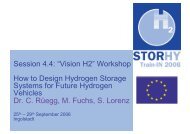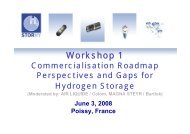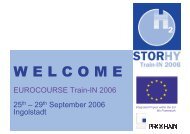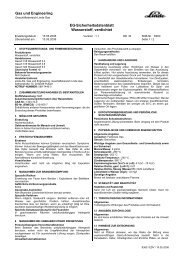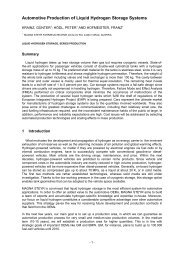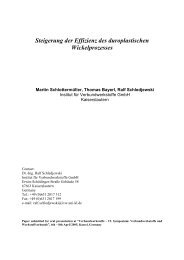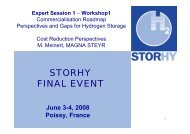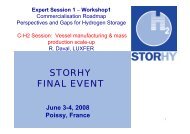cryogenic filling: State-of-the-art and perspectives (Linde / Reijerkerk)
cryogenic filling: State-of-the-art and perspectives (Linde / Reijerkerk)
cryogenic filling: State-of-the-art and perspectives (Linde / Reijerkerk)
You also want an ePaper? Increase the reach of your titles
YUMPU automatically turns print PDFs into web optimized ePapers that Google loves.
“Conventional” <strong>cryogenic</strong> LH2<br />
refuelling technology<br />
StorHy , June 3rd 2008, Paris
“Conventional” <strong>cryogenic</strong> <strong>filling</strong> technologies:<br />
stationary installation<br />
2
“Conventional” <strong>cryogenic</strong> <strong>filling</strong> technologies:<br />
stationary installation<br />
3
“Conventional” <strong>cryogenic</strong> <strong>filling</strong> technologies:<br />
stationary installation<br />
4
“Conventional” <strong>cryogenic</strong> <strong>filling</strong> technologies:<br />
stationary installation<br />
5
“Conventional” <strong>cryogenic</strong> <strong>filling</strong> technologies:<br />
stationary installation<br />
6
“Conventional” <strong>cryogenic</strong> <strong>filling</strong> technologies:<br />
relocatable installation<br />
7
“Conventional” <strong>cryogenic</strong> <strong>filling</strong> technologies:<br />
relocatable installation<br />
8
“Conventional” <strong>cryogenic</strong> <strong>filling</strong> technologies<br />
<strong>State</strong> <strong>of</strong> <strong>the</strong> Art – Filling Process<br />
Dispenser integrated weight compensation system<br />
Verknüpfung mit Ablauf.lnk<br />
9
“Conventional” <strong>cryogenic</strong> <strong>filling</strong> technologies<br />
<strong>State</strong> <strong>of</strong> <strong>the</strong> Art – Refuelling Interface<br />
Vehicle<br />
Station<br />
10
“Conventional” <strong>cryogenic</strong> <strong>filling</strong> technologies<br />
<strong>State</strong> <strong>of</strong> <strong>the</strong> Art – Filling Process – future challenges<br />
<strong>State</strong> <strong>of</strong> <strong>the</strong> Art<br />
— LH2 Filling process (incl. storage, sub-cooling) has been installed<br />
<strong>and</strong> daily operated at public refueling sites<br />
— System is highly reliable <strong>and</strong> shows repeatable performance<br />
— A sub-cooled refueling rate <strong>of</strong> 50 litres /min* is st<strong>and</strong>ard for<br />
refueling with LH2 transfer pumps<br />
— The refueling process <strong>and</strong> hardware has proven functionality in a<br />
temperature range <strong>of</strong> -40°C to +80°C<br />
— More than 30.000 <strong>filling</strong>s performed (Status Q1 2008)<br />
* Conventional fuels Diesel <strong>and</strong> Gasoline are refueled at 50litres/min at public refuelling sites<br />
11
“Conventional” <strong>cryogenic</strong> <strong>filling</strong> technologies<br />
<strong>State</strong> <strong>of</strong> <strong>the</strong> Art – Filling Process – future challenges<br />
Future Challenges <strong>of</strong> LH2 <strong>filling</strong> process<br />
— Advancement <strong>of</strong> data interface (non-mechanical connection,<br />
dataset)<br />
— Calibratable <strong>cryogenic</strong> LH2 flow measurement<br />
— Minimization <strong>of</strong> H2 “return-gas” during <strong>filling</strong> by<br />
improvements <strong>of</strong> receiving tank (less pressure losses)<br />
12
“Conventional” <strong>cryogenic</strong> <strong>filling</strong> technologies<br />
<strong>State</strong> <strong>of</strong> <strong>the</strong> Art – Filling Process – future challenges<br />
Minimize <strong>of</strong> H2 “return-gas” during <strong>filling</strong><br />
Zero H2-Return gas <strong>filling</strong> with sub-cooled LH2 is proven <strong>and</strong> tested<br />
Necessary precautions to meet <strong>the</strong> technical requirements are:<br />
— Pre-cooling <strong>of</strong> <strong>filling</strong> line at <strong>the</strong> <strong>filling</strong> station to less than 80 K<br />
— Filling line as short as possible<br />
— Minimized pressure losses in valves <strong>and</strong> tubes inside <strong>the</strong> vehicle<br />
tank system (Goal: pressure losses
“Conventional” <strong>cryogenic</strong> <strong>filling</strong> technologies<br />
Test: Zero <strong>filling</strong> losses due to sub-cooled LH2 (1994)<br />
Filling<br />
volume<br />
(litre)<br />
Filling<br />
losses<br />
Filling time<br />
Storage vessel<br />
Vehicle vessel<br />
Filling-line precooled<br />
Average <strong>filling</strong> flow<br />
Max. <strong>filling</strong> flow<br />
subcooled hydrogen 3,6 barg, about 21,8 K<br />
3 barg, about 26 K, special spraying liquid <strong>filling</strong> line<br />
80 K<br />
2400 ltr/h = 170 kg/h<br />
5000 ltr/h = 354 kg/h<br />
14
“Conventional” <strong>cryogenic</strong> <strong>filling</strong> technologies<br />
Test: Zero <strong>filling</strong> losses due to sub-cooled LH2 (2003)<br />
15
Thank you for your attention.<br />
www.linde.com/hydrogen
“Conventional” <strong>cryogenic</strong> <strong>filling</strong> technologies<br />
<strong>State</strong> <strong>of</strong> <strong>the</strong> Art – Filling Process<br />
17





